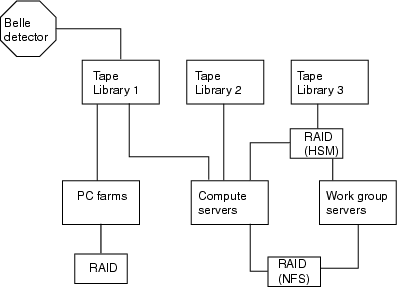



Next: Tape Libraries and Servers
Up: Offline Computing System
Previous: Offline Computing System
Contents
The maximum data rate from the Belle detector, discussed in the
previous section, is 15 MB/s, which corresponds to the maximum trigger
rate of 500 Hz and the maximum event size of 30 KB. Raw data are
accumulated at the rate of about 5 MB/s, corresponding to 400 GB/d or
80 TB/y. The traditional-style data summary tapes, DSTs, are produced
from tape to tape by running the reconstruction algorithms on raw
data. DSTs contain only physics events and thus the size of DST is
reduced to 4 GB per pb . As we have taken data of 6.8 fb
. As we have taken data of 6.8 fb between October 1999 and July 2000, we have produced 28 TB of DST.
In order to satisfy the above offline computing needs, a large
computing system has been set up at the computing research center of
KEK. The system consists of a computing server system, a RAID disk
system and tape library system for mass storage, work group servers,
and high speed network systems. The network systems connect all the
sub-systems. The main purpose of the offline computing system is to
process data taken by the Belle detector and to store them so that
users can analyze them. Fig.
between October 1999 and July 2000, we have produced 28 TB of DST.
In order to satisfy the above offline computing needs, a large
computing system has been set up at the computing research center of
KEK. The system consists of a computing server system, a RAID disk
system and tape library system for mass storage, work group servers,
and high speed network systems. The network systems connect all the
sub-systems. The main purpose of the offline computing system is to
process data taken by the Belle detector and to store them so that
users can analyze them. Fig. ![[*]](./icons/crossref.png) shows a schematic
diagram of the Belle computing system.
The computing server system consists of seven Ultra Enterprise
servers. Each server has 28 167-MHz Ultra SPARC CPUs and is rated to
be more than 7000 SpecInt92s. Each server has 7 GB of physical memory
so that the parallel reconstruction processes can be run without
swapping memories.
shows a schematic
diagram of the Belle computing system.
The computing server system consists of seven Ultra Enterprise
servers. Each server has 28 167-MHz Ultra SPARC CPUs and is rated to
be more than 7000 SpecInt92s. Each server has 7 GB of physical memory
so that the parallel reconstruction processes can be run without
swapping memories.
Figure:
Block diagram of the Belle computing system.

|




Next: Tape Libraries and Servers
Up: Offline Computing System
Previous: Offline Computing System
Contents
Samo Stanic
2001-06-02
